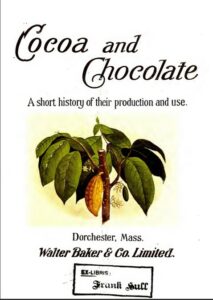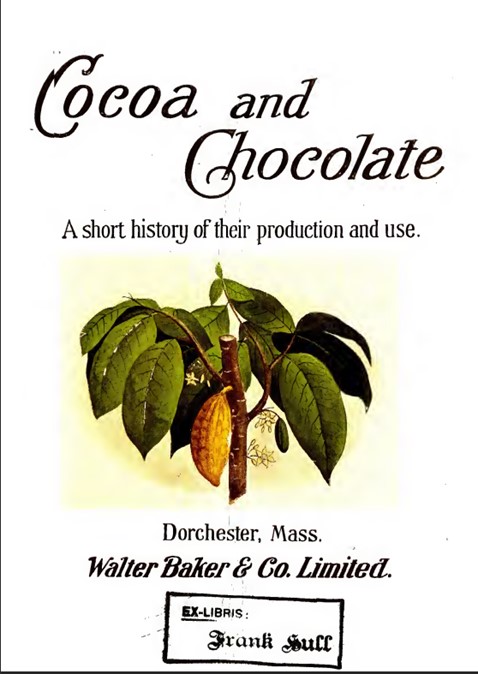Coca and Chocolate
A short history of their production and use.

Coca and Chocolate – THIS publication is made up in part of original matter and in part of matter reprinted from three of our previous publications, now out of print, namely: ” Cocoa and Chocolate: A Short History of Their Production and Use,” — a 12mo of 152 pages, published in 1886; “
The Chocolate Plant and Its Products,” — a small 4to of 40 pages, published in 1891; and “Cocoa and Chocolate: A Short History of Their Production and Use,” a quarto of 72 pages, first printed in 1899 and reprinted in 1901, 1904, 1907, and 1910. Copies of them can be found in many of the public and school libraries in the United States.
We have included in this work some new views of our mills and workrooms, and also some engravings from photographs taken in the West Indies and in Ceylon, showing the present methods of gathering and curing the fruit of the cocoa tree.
As even the standard dictionaries fail to give the exact meanings of the word’s “cocoa” and “chocolate,” we give here accurate definition of those terms –
Cocoa. — The commercia] name given
(l) to the seeds of the small tropical tree known to botanists as Theobroma Cacao;
(2) to the cracked or coarsely ground product of the roasted seeds, sometimes designated more particularly as “cocoa nibs,” or “cracked cocoa”;
(3) to the finely pulverized product of the roasted seeds from which a portion of the fat has been removed, sometimes designated as “breakfast cocoa” or ‘ powdered cocoa.
Chocolate. — (1) The solid or plastic mass produced by grinding to fineness the kernel of the roasted seeds of Theobroma Cacao without removing any of the fat, sometimes called “plain chocolate”;
(2) the same product to which have been added sugar and various flavoring substance’s, sometimes known as “sweet chocolate ” or “vanilla chocolate.”
COCOA AND CHOCOLATE
PRODUCTION AND CONSUMPTION
DURING the last thirty or more years the consumption of cocoa in various forms has increased to an extraordinary extent not only in this country, but in the United Kingdom —countries in which the greatest progress is being made in the science of nutrition, and in the inventions which have done so much to cheapen the cost and improve the quality of articles of food.
This increase in consumption is due to several causes, among the most prominent of which are (1) a reduction in the retail price, bringing it within the means of the poorer classes; (2) a more general recognition of the value of cocoa as an article of food, and (3) improvements in methods of preparation, by which it is adapted to the wants of the different classes of consumers.
There is no doubt that, if it had not been for the monopoly of the production which Spain long possessed, and which kept the price, on its introduction into England, at a point where only the rich could afford to buy it, cocoa would have come into as general use there as it did in Spain, and would, perhaps, have been received with more favor than tea or coffee, which were introduced about the same time.
It appears that, in the time of Charles II., the price of the best chocolate (very crude undoubtedly, as compared with the present manufactures) was 6s. 8d. a pound, which, if we take into account the greater purchasing power of money at that time, would be equal to at least $5.00 a pound at this time for a very coarse article.
Humboldt estimated the consumption of cocoa in Europe, in 1806, as 23,000,000 pounds per annum, of which from 6,000,000. to 9,000, -000 were supposed to be consumed in Spain. The estimated consumption in Europe at the present time is over 225,000,000.
At recent estimate of the total amount of crude cocoa exported from the tropical regions in which it is grown, based partly on official figures and partly on expert estimates, is above 600,000,000 pounds per annum.
In the report of the U. S. Bureau of Statistics for the fiscal year ending Dec. 31, 1916, the principal importations of crude cocoa into this country are given as follows: British West Indies, 40,898, – 190 pounds; Dominican Republic, 49,053,832; Brazil, 31,904,817; Ecuador, 44,644,568; other South American countries, 56,090,090; European countries, 20,025,557.
In the United Kingdom the amount consumed in 1831 was only } i of an ounce for each inhabitant. In 1915 it had risen to about 36 ounces; that is, about 104,205,000 pounds. The percentage of increase since 1860 has been much greater than that of tea or coffee.
In that year the consumption of tea was 2.67 pounds for each inhabitant; of coffee, 1.23 pounds; of cocoa, 2 ounces.
In 1915, the consumption of tea was 6.89 pounds for each inhabitant; of coffee, only ll Yi ounces; of cocoa, about 36 ounces. It appears from this that in Great Britain and Ireland cocoa is actually taking the place of coffee, the per capita use of the former having greatly increased, while the per capita use of the latter has greatly decreased.
Any statement covering the period following the outbreak of the great war in Europe in the summer of 1914, relative to the consumption of cocoa in that part of the world, should be considered with some qualification, as absolutely accurate figures are not obtainable.
In the United States the increased consumption of cocoa in recent years has been even more striking. The amount retained for home consumption in 1860 was only 1,181,054 pounds, or % of an ounce for each inhabitant. The average annual consumption for the three years, 1914, 1915, and 1916, amounted to 194,691,014 pounds. ^
This shows an increase greatly in excess of the increase during the same period in the consumption of coffee and tea. In 1860, the consumption of coffee per capita was 5.79 pounds; in 1916 it was about 11 pounds.
The consumption of tea in 1860 was about 13>^ ounces per capita; in 1916 it was about 16J^ ounces. The consumption of cocoa had risen during the same period from % of an ounce to about 30J^ ounces per capita.
Statements in the press and in the reports of the Pure Food Commissioners show that there are on the market at this time many cocoas and chocolates which have been treated with adulterants, more or less injurious to health, for the purpose of cheapening the cost and giving a fictitious appearance of richness and strength.
The safest course for consumers, therefore, is to buy goods bearing the name and trademark of a well-known and reputable manufacturer, and to make sure by a careful examination that they are getting what they order.
READ MUCH MORE INSIDE…
DOWNLOAD NOW “COCA AND CHOCOLATE” $47


Click on the Red Button Below for Instant Access!
Our 100% Money Back Guarantee:

If for any reason you decided within 30 days that “COCA AND CHOCOLATE” isn’t for you, simply notify us by email and we’ll gladly refund your money – no questions asked. That’s our Ironclad Guarantee!
The risk is entirely ours! You absolutely have nothing to lose!
Your name and email will Never be shared, sold, or given to anyone.
We keep our subscriber’s privacy sacred. We do not sell or rent your personal information to other parties. What’s more you can always unsubscribe at any time!
Your name and email will Never be shared, sold, or given to anyone.
We keep our subscriber’s privacy sacred. We do not sell or rent your personal information to other parties. What’s more you can always unsubscribe at any time!
Regards,
Coyalita Linville
Copyright © 2021-2023 ttfnicheincomecoyalita.com. All Rights Reserved Privacy Policy – Earnings Disclaimer – Terms of Use – Contact Us
